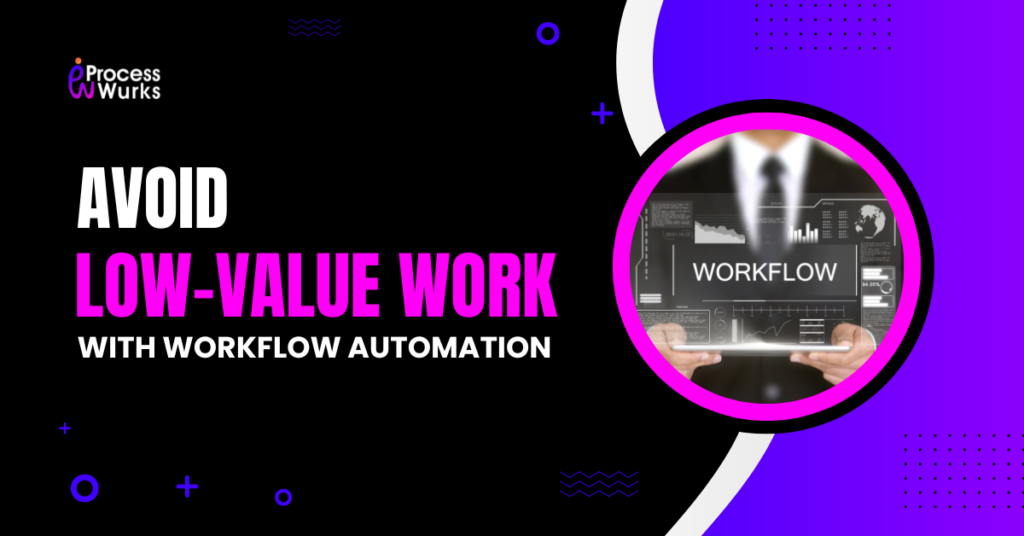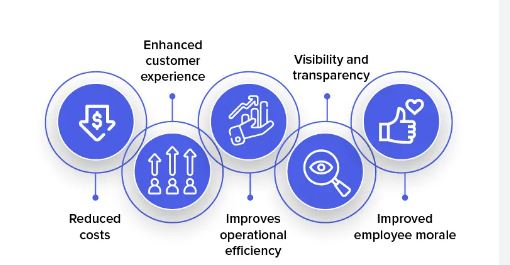
Share This Post
Welcome to our blog on “Avoiding Low-Value Work with Workflow Automation.” Discover the power of automation in optimizing business processes and unlocking more valuable time. By utilizing automation tools, businesses can eliminate manual inefficiencies and concentrate on growth, innovation, and customer satisfaction.

In this blog, we’ll explore crucial aspects of workflow automation, such as identifying low-value tasks, selecting the ideal tools, streamlining processes, fostering collaboration, and maximizing automation benefits. Join us as we unveil the transformative potential of automation, allowing you to reclaim your time for more valuable pursuits.
What Exactly is Workflow Automation?
Workflow Automation is the design, execution, and computerization of processes based on workflow rules, in which human jobs, data, or files are sent from one person or system to another based on business rules that have already been set.

Automation takes the place of processes that workers usually do by hand and makes them much better. With technology in place, you can expect:
- Efficiency
- Accuracy
- Compliance
- Workplace Happiness and Productivity
Why is Automating Work Processes Important?
The automation of work processes has made things easier for workers. Trying to do too many things at once leads to stress and increases the chance of making mistakes. But workflow automation helps businesses simplify jobs and reduce the amount of work that people have to do.
When to Use Automation Workflow
Workflow engines are made to help speed up processes and make sure that jobs are done correctly, on time, and in an organized way. You can use them to automate boring chores like approving expenses, paying bills, and making reports. This can give staff more time to work on more important things.
Advantages of Automating Work Processes
Advantages for Business
Automation cuts down on mistakes made by people and gets rid of many time-consuming and repetitive jobs, like entering data by hand. Organizations that use labor- and capital-intensive processes that are out of date and done by hand can’t safely grow. By adding automation, companies are better able to grow as they need to.

Businesses also get benefits from workflow automation in the following ways:
- Makes systems that save money.
- Streamlines job management
- Shortens the time a process takes.
- Errors from human entries or mistakes are less likely to happen.
- Automates the flow of approvals and documents
Developers and Operations (DevOps) Can Benefit From this
Workflow automation leads to better releases and better ways for coders and operations, which have always been separate areas, to talk to each other. It breaks down common DevOps problems, like bottlenecks and follow-ups, that happen when developer and operations routes are kept separate.
IT Network Management Can Benefit From This
By automating processes, administrators can keep a better eye on how the cloud, network, operating system, and different departments work together. It also adds a key layer of visualization that makes it easier to set up, monitor, and evaluate network health, security, and problems.
How Workflow Automation Removes Low-Value Work
Low-value work could be a request or approval that gets stuck in an email chain, causing delays and confusion. It could also be manually re-keying information from paper records or different systems, sending back-and-forth documents that need to be fixed or need more information, or sorting through different versions of files that will cause deadlines to be missed.
When you automate your workplace, smart office automation takes the place of low-level, manual office work. Most automated choices use simple logic, such as “if the request is for more than $50,000, send it to the CFO for approval” or “if the checkbox on the I9 form is blank, send it back to HR.”
With all of these manual procedures and the possibility of mistakes, it’s hard not to waste time on less important things. Based on clever business rules, automation will move information forward. This will save hours of time each week.
Automating these simple logic stages eliminates the need to open emails or paper forms, find the next step, and scan it. Instead, the workflow engine calls on individuals when needed.
Examples of Automating Work Processes
With the right tools and system, any group, any process, or any part of a process can be automated. Integrify, for example, has free process apps that you can download that already have tasks and forms set up so that you can get your workflow up and running and imported quickly. There are more than 30 steps that span 8 different types of departments.
Workflow use cases show you what you can do with software that automates work processes. On our workflow use case example sheet, you can see a list of processes that can be made better by automating workflow, such as:
- New Hire Management in HR teams
- Approvals of invoices in buying departments
- The approval process for collateral in marketing departments
- Setting up a new account in IT areas
- Sales offices offer discounts on prices.
- CapEx/AFE Requests in Finance areas
What is the Value of Process Automation?
Money is saved through workflow automation. Workplace automation can help you save money on business costs by getting rid of costly mistakes and making it easier for workers to do their jobs. You might also save money on administrative work because jobs that are done over and over again and take a lot of time will be done automatically.
What Factors Affect Workflow Automation?

Let’s look at the six steps you need to take to automate your business’s job and process workflow:
- Identify repeated tasks
- Make a flowchart
- Set up and release the process
- Check the efficiency of the workflow
- Educate the workers
- Key success indicators should be tracked
Conclusion
In conclusion, leveraging workflow automation is a game-changer for businesses seeking to eliminate low-value work and maximize productivity. By automating repetitive and time-consuming tasks, organizations can focus on strategic initiatives, innovation, and delivering exceptional customer experiences. Workflow automation streamlines processes enhances efficiency, reduces errors, and enables seamless collaboration.
To dive deeper into the topic and explore how workflow automation can revolutionize your business, visit our website at ProcessWurks. Discover the transformative potential of automation and reclaim your time for high-value endeavors. Take the first step towards optimizing your workflows and unlocking greater business success.
Editor’s Choice:
Want to automate your firm? Try ProcessWurk free trial today
ONE Software to run your entire business. From Marketing to Sales to Client on-boarding to Client deliverables to Firm Operations
More To Explore





